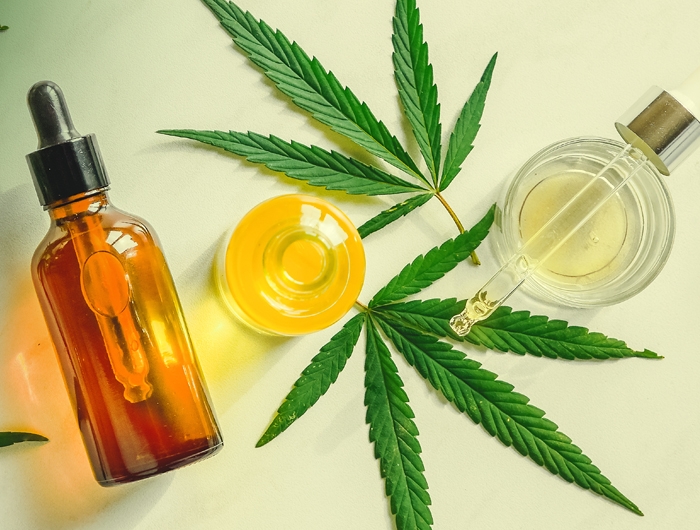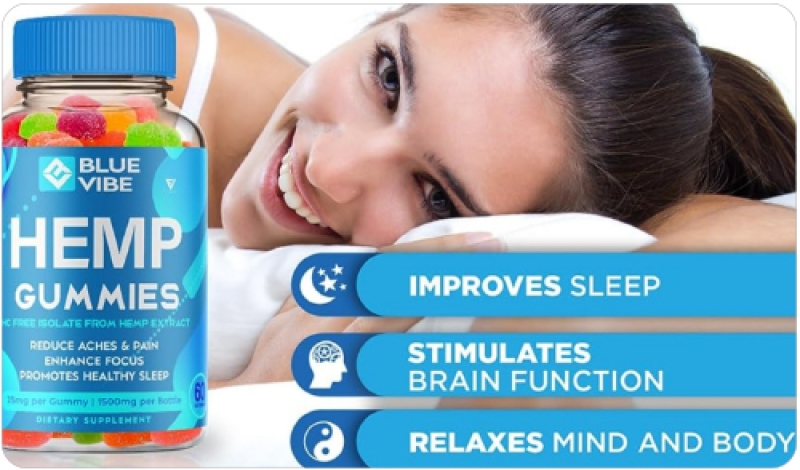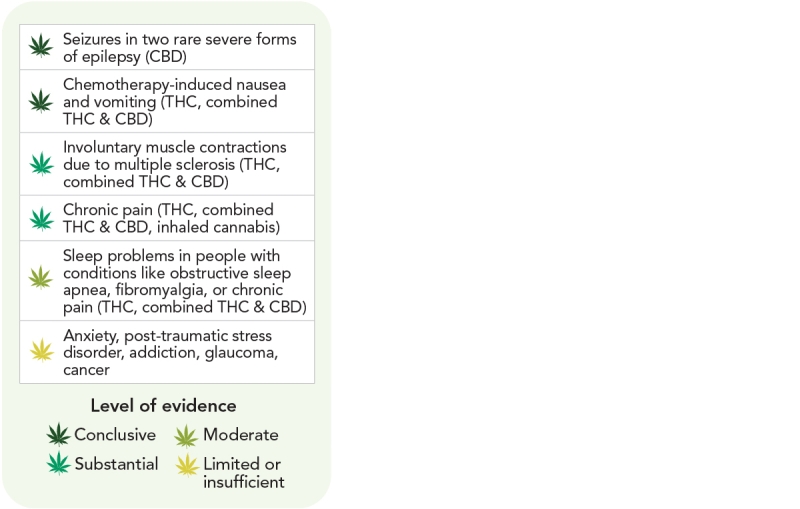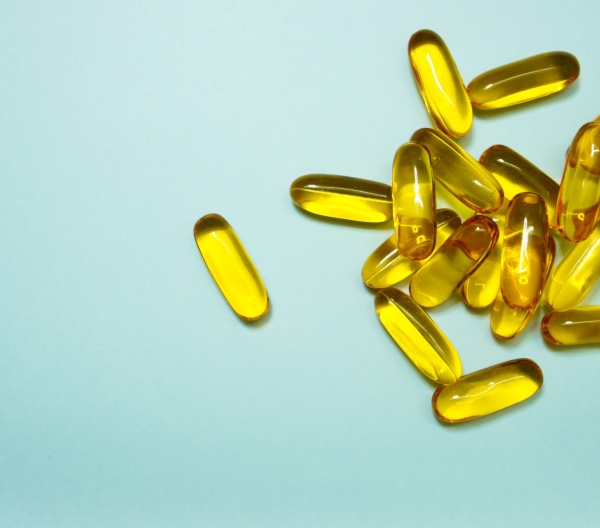Weeding through the evidence to clear the cannabis confusion

Irina - stock.adobe.com.
Marijuana (aka cannabis) and THC, its intoxicating component, are legal in dozens of states. And enthusiastic claims for CBD, its non-intoxicating component, flourish online and in some drugstores. But confusion abounds about what cannabis and its components can—or can’t—do for your health.
1. How many gummies?
Marijuana and THC are illegal, says the U.S. Drug Enforcement Administration (DEA). Yet both are legal in many states. (How can that be? It’s a long story.)
And in states where marijuana can be purchased for medical or recreational use, THC can be sold not just as weed to smoke or cartridges to vape, but as gummies, brownies, and other snacks.
Those “edibles” don’t come with risks like chronic bronchitis from smoking marijuana or lung injury from vaping it. But it’s easy to get the dose wrong.
“It’s really an issue with edibles,” says Jessica Kruger, a clinical associate professor at the University at Buffalo, SUNY, who is an expert on addictive behaviors.
“When people smoke or vape THC, they feel the effects almost immediately. But with edibles, it can take 60 to 90 minutes to start feeling it.”
That can spell trouble for those who, unaware of the lag time, pop another serving after, say, 30 minutes.

And the label may not help. “It’s a total patchwork with no standardization across states,” says Kruger.
In her 2022 survey of regulations in 31 states, only 14 required the label to say how much THC was in a serving.
And you can’t assume that a chocolate bar, cookie, or THC soda is only one serving. What looks like a single-serving food may contain 10 or more doses of THC.
What is a dose of THC? “Some guidelines say it’s 5 milligrams, others say 10,” says Kruger.
“And if you have a THC cookie that has 10 mg per serving, but you eat the whole thing because you didn’t read or understand that the serving size is a quarter of a cookie, you’re going to have a pretty wild time.”
In fact, after a whopping 40 mg of THC, that “wild time” may result in extreme anxiety, paranoia, a racing heart, nausea, or vomiting.
2. Is the label reliable?
In 2017, Ryan Vandrey, a professor of psychiatry and behavioral sciences at the Johns Hopkins School of Medicine, found that only about 30 percent of the 84 CBD products his team bought online were accurately labeled. (CBD made from hemp—which has 0.3 percent or less THC—is legal, says a national law, but you can’t get it in all states.)
Not much has changed since then. “Other groups have also consistently found that label accuracy is poor,” says Vandrey.
What’s more, researchers found that CBD products were often contaminated with THC. The THC levels were typically too low to intoxicate most adults, but some had enough to intoxicate children or lead to a failed drug test.
3. Can CBD fix...everything?
If the “self-care” movement had a poster child, it might be CBD.
Promises that CBD will ease anxiety, curb pain, improve sleep, reduce PTSD symptoms, treat opioid addiction, and more are everywhere. (The FDA and the FTC have told companies to stop claiming that CBD can treat diseases like cancer, Alzheimer’s, autism, and multiple sclerosis.)
The evidence is far less thrilling, though there are a few promising hints.
For example, in one study of 37 young adults with social anxiety disorder, those who took 300 mg a day of CBD for four weeks had slightly lower anxiety scores on questionnaires than those who took a placebo.
“While CBD might be helpful for anxiety or pain or sleep, we don’t have definitive clinical trials that demonstrate effectiveness for any of those outcomes,” says Vandrey.
So far, most studies have been small or poorly designed.
“But I think we’re going to see a huge influx of good clinical research on the therapeutic effects of CBD in the next couple of years,” adds Vandrey.
CBD does have one proven benefit: In 2018, the FDA approved a high-dose CBD prescription medication, Epidiolex, to treat seizures in two severe forms of epilepsy.
Cured by cannabis?
Here’s the strength of the evidence that cannabis can help with:

4. What’s with Delta-8 THC?
There’s a new THC in town, and it’s called delta-8. It’s nearly identical to delta-9, the main THC in cannabis.
While delta-8 THC occurs naturally at very low levels in cannabis, the form that’s sold in gummies, vape pens, and more is made synthetically by converting CBD from hemp to delta-8 THC.
Why is delta-8 so popular?
Some people claim that it creates less anxiety, paranoia, and brain fog than delta-9 THC. That may be due to delta-8’s different chemical structure.
“It doesn’t fit into the receptor in the brain as well as delta-9,” Kruger explains. “It’s like a square peg in a round hole.” But so far, there’s no solid evidence that delta-8 lives up to any of its claims.
What’s more, its legal status is cloudy (as is just about everything cannabis).
When the U.S. government legalized CBD made from hemp in 2018, a market for delta-8 THC was born. Because it’s made from CBD, delta-8 THC started showing up everywhere from health food stores to gas stations, even in states where delta-9-THC was illegal.
In 2020, the DEA declared that it considers delta-8 THC illegal. But that decision isn’t widely enforced.
Meanwhile, some states have banned delta-8 sales due to safety concerns.
“We worry about contamination caused from the process of making delta-8 from CBD,” Kruger explains.
When researchers analyzed 27 delta-8 vape cartridges, they found heavy metals like lead and mercury along with delta-9 THC.
“Delta-8 is the Wild West,” says Kruger. “Buyer beware.”
5. Does CBD mellow a THC high?
A few studies suggest that CBD may blunt the adverse effects of THC like anxiety and a racing heart. But in other studies, CBD does nothing...or makes things worse.
So Vandrey randomly assigned 18 adults to eat brownies with either a placebo, 20 mg of THC, or 20 mg of THC plus 640 mg of CBD on separate days.
“We found that when you add CBD to the mix, it blocks THC metabolism, so you end up with far higher concentrations of THC in the blood,” says Vandrey. “That contributes to stronger rather than weaker drug effects versus when THC is taken without CBD.”
On the THC-plus-CBD day, the volunteers performed worse on cognitive tests, had a higher heart rate, and were more likely to feel “sick” or experience an “unpleasant drug effect” than when they took THC alone. (Those drug effects may be less intense if the drugs are inhaled, says Vandrey.)
That said, you’d be hard-pressed to find a retail item with 640 mg of CBD.
“That’s about the dose for the prescription CBD medication Epidiolex,” says Vandrey. “So we started there. Now, we’re trying to figure out the level of THC and CBD that’s tolerable and doesn’t cause cognitive impairment.”
Stay tuned.
Tags
Topics

OUR HEALTHLETTER
Subscribe to Nutrition Action
Nutrition Action is completely independent. We accept no advertising and take no donations from corporations or the government. So we’re free to blow the whistle on dishonest products and to applaud the good ones.

